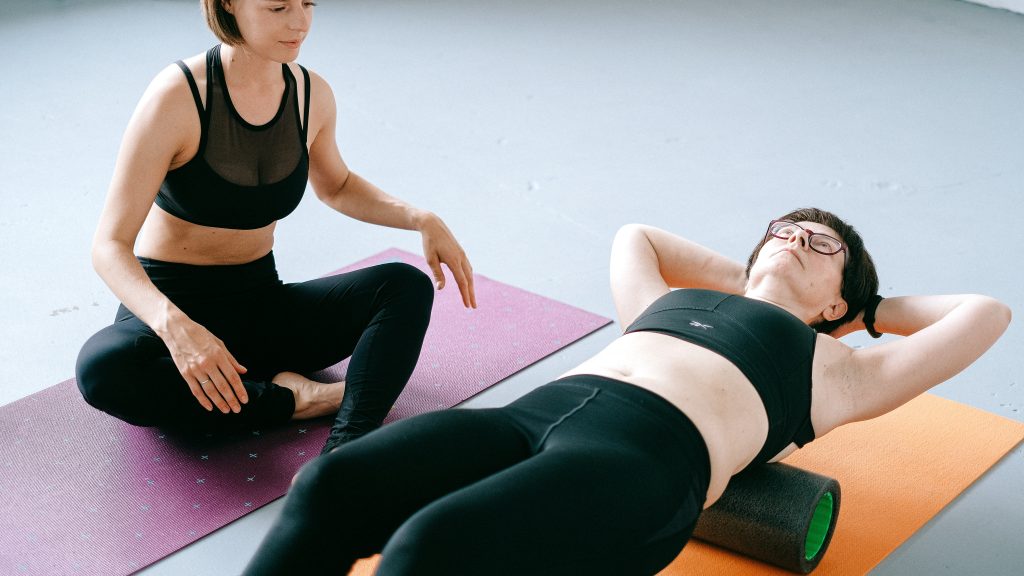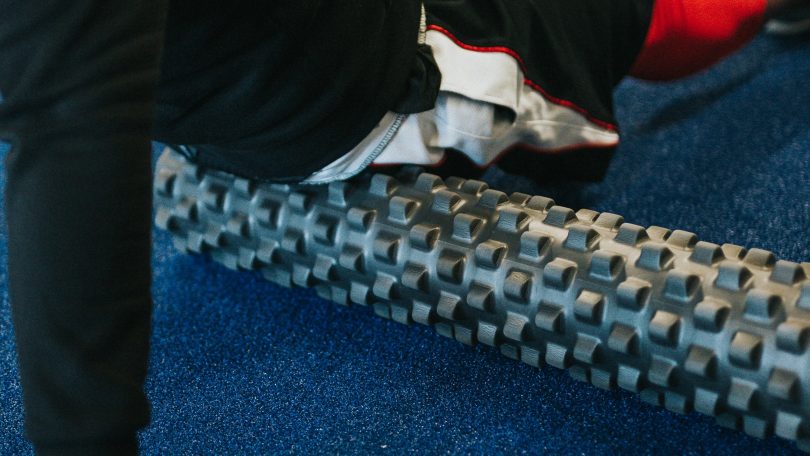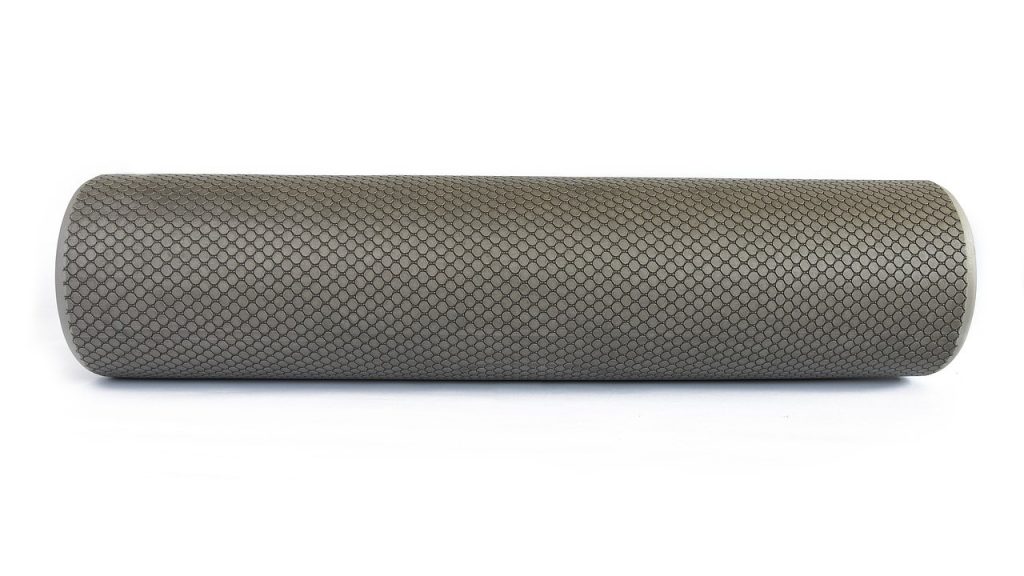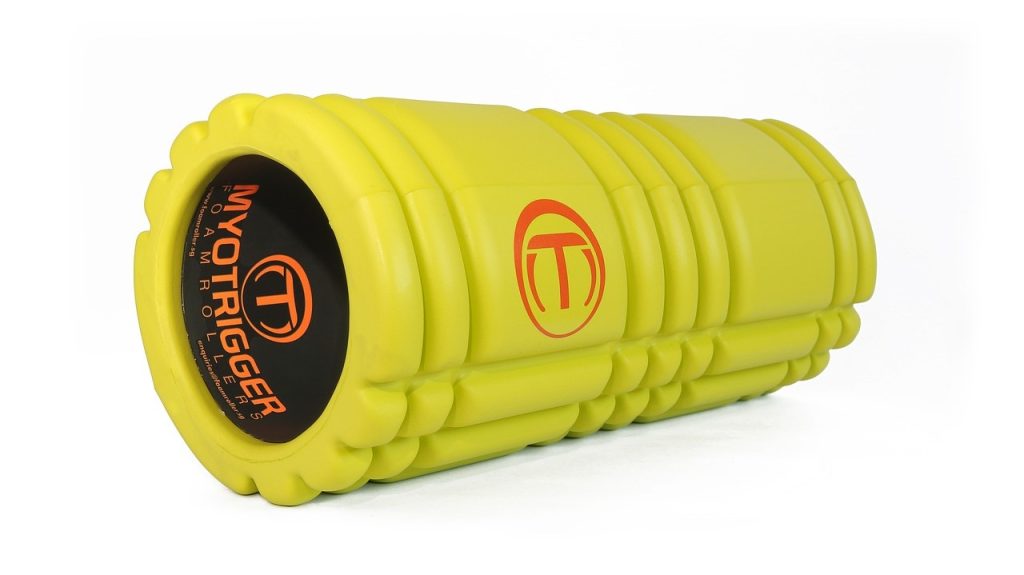Introduction:
Foam rolling has gained immense popularity in the fitness community as a powerful tool for post-workout recovery. This simple yet effective technique involves using a foam roller to apply pressure on muscles, helping to release tension, improve flexibility, and enhance overall recovery. In this article “Maximize Your Post-Workout Recovery with Foam Rolling: Unleash the Benefits of this Powerful Gym Tool”, we will explore the numerous benefits of foam rolling and provide a step-by-step guide on how to incorporate it into your post-workout routine.
-
What is foam rolling?
- Definition: Foam rolling is a self-myofascial release technique that involves using a foam roller to apply pressure on specific muscle groups.
- Purpose: The main objective of foam rolling is to release tension and adhesions in the muscles and connective tissues, promoting better recovery and reducing muscle soreness.
-
Benefits of foam rolling:
- Muscle recovery: Foam rolling helps to increase blood flow to the muscles, promoting faster recovery and reducing muscle soreness after intense workouts.
- Injury prevention: Regular foam rolling can help prevent injuries by improving muscle flexibility and joint range of motion.
- Increased range of motion: By targeting tight areas and trigger points, foam rolling helps to enhance flexibility and improve joint mobility.
- Improved performance: Incorporating foam rolling into your post-workout routine can lead to improved athletic performance by enhancing muscle activation and reducing muscle imbalances.
- Stress relief: Foam rolling has a relaxing effect on the body, helping to reduce stress and promote overall well-being.
-
How to foam roll effectively:
- Choose the right foam roller: Opt for a high-quality foam roller that suits your specific needs, considering factors such as density and texture.
- Warm-up before foam rolling: Prior to foam rolling, engage in a brief warm-up routine to increase blood flow to the muscles and prepare them for the rolling session.
- Target specific muscle groups: Focus on the major muscle groups that were worked during your workout, such as the quads, hamstrings, calves, glutes, and back.
- Apply moderate pressure: Roll slowly and apply moderate pressure on each muscle group, pausing on any tight or tender areas for 20-30 seconds.
- Maintain proper form: Ensure that you maintain proper form throughout the foam rolling session, keeping your core engaged and avoiding excessive pressure on joints or bones.
- Breathe and relax: Take deep breaths while foam rolling to promote relaxation and allow the muscles to release tension.
- Frequency and duration: Aim to foam roll for 10-15 minutes after each workout session, but adjust the duration based on your individual needs and time constraints.
-
Additional tips for maximizing foam rolling benefits:
- Stay hydrated: Adequate hydration is crucial for effective muscle recovery, so drink plenty of water before and after your foam rolling session.
- Combine with other recovery techniques: Foam rolling can be complemented with other post-workout recovery techniques such as stretching, mobility exercises, and cold or hot therapy.
- Consult a professional: If you’re new to foam rolling or have specific concerns or injuries, consider consulting a fitness professional or physical therapist for guidance and personalized advice.
-
Foam rolling techniques for specific muscle groups:
- Quads: Start in a plank position with the foam roller placed under your thighs. Roll from the top of your thighs to just above the knees, focusing on any tight or tender spots.
- Hamstrings: Sit on the foam roller with your legs extended in front of you. Roll from the glutes down to just above the knees, pausing on any areas that feel tight or need extra attention.
- Calves: Sit on the floor with the foam roller positioned under your calves. Roll from the ankles to just below the knees, targeting any tight spots along the way.
- Glutes: Sit on the foam roller with one ankle crossed over the opposite knee. Roll back and forth, applying pressure to the glute muscles. Switch sides to target both glutes.
- Back: Lie on the foam roller with it positioned horizontally along your spine. Roll from the upper back to the lower back, focusing on any areas of tension or discomfort.
- Shoulders: Stand facing a wall with the foam roller placed between the wall and your shoulder blades. Lean into the roller, allowing it to massage the upper back and shoulders.

Photo by Anna Shvets: https://www.pexels.com/photo/a-trainer-watching-her-client-use-a-foam-roller-4587694/
-
Foam rolling for specific sports or activities:
- Running: Foam rolling can be beneficial for runners to release tension in the calves, quads, and hamstrings, reducing the risk of injuries such as shin splints or IT band syndrome.
- Weightlifting: Foam rolling can help weightlifters improve mobility and flexibility in muscles targeted during lifting exercises, such as the glutes, quadriceps, and upper back.
- Cycling: Foam rolling can aid cyclists in releasing tension in the hips, quadriceps, and calves, enhancing range of motion and reducing the risk of overuse injuries.
- Team sports (soccer, basketball, etc.): Foam rolling can be used to target muscles commonly engaged in team sports, such as the hip flexors, hamstrings, and shoulders, helping to prevent muscle imbalances and maintain optimal performance.
-
Common misconceptions about foam rolling:
- Myth: Foam rolling eliminates the need for stretching.
- Reality: While foam rolling can provide benefits similar to stretching, it is still important to incorporate dynamic and static stretching into your routine. Stretching helps improve flexibility and joint mobility, while foam rolling primarily targets muscle tension and adhesions.
- Myth: Foam rolling should be painful to be effective.
- Reality: Foam rolling may cause some discomfort, especially when targeting tight or knotted muscles. However, it should not be excessively painful. Apply enough pressure to feel a release, but avoid intense pain that could indicate tissue damage.
- Myth: Foam rolling can completely prevent muscle soreness.
- Reality: Foam rolling can help reduce muscle soreness and expedite recovery, but it may not completely eliminate post-workout soreness. Soreness is a natural response to exercise, and foam rolling is just one tool to aid in recovery.
- Myth: Foam rolling can break up muscle knots.
- Reality: Foam rolling can help release tension and tightness in muscles, but it doesn’t physically break up muscle knots. The pressure from foam rolling stimulates the nervous system and increases blood flow, promoting muscle relaxation.
-
Incorporating foam rolling into your overall fitness routine:
- Pre-workout warm-up: Prior to your workout, use foam rolling as part of your warm-up routine to increase blood flow, enhance mobility, and prepare your muscles for the upcoming activity. Focus on rolling major muscle groups involved in your workout.
- Post-workout recovery: Foam rolling after your workout can help reduce muscle soreness, prevent tightness, and enhance recovery. Spend extra time targeting specific muscles that were heavily engaged during your training session.
- Active rest days: On days when you’re not engaging in intense workouts, use foam rolling as a form of active recovery. It can help increase blood flow, relieve muscle tension, and promote relaxation.
- Maintenance sessions: Even on days when you’re not exercising, consider incorporating short foam rolling sessions into your routine. This can help prevent muscle imbalances, maintain flexibility, and optimize overall muscle health.
-
Choosing the right foam roller:
- Density: Foam rollers come in different densities, ranging from soft to firm. Softer foam rollers are more forgiving and suitable for beginners or those with sensitive muscles, while firmer foam rollers provide deeper tissue release for individuals with more experience or denser muscle mass.
- Texture: Some foam rollers have textured surfaces, such as grids or ridges, which can provide enhanced stimulation and targeted massage to specific areas. Consider the texture that feels most comfortable and effective for your needs.
- Size and shape: Foam rollers come in various lengths and diameters. Longer foam rollers (around 36 inches) are suitable for full-body rolling and targeting larger muscle groups, while shorter ones (around 18 inches) are more portable and ideal for specific areas. Additionally, foam rollers with varying shapes, such as half-round or contoured, can offer better support and access to certain muscle groups.
- Specialty foam rollers: There are specialized foam rollers available for specific purposes, such as foam rollers with vibration or textured surfaces for enhanced muscle stimulation. These may provide additional benefits but are generally more expensive.
-
Frequency and duration of foam rolling:
- Post-workout: It is recommended to foam roll after each workout session to promote recovery and reduce muscle tension. Aim for 10-15 minutes of foam rolling, focusing on the major muscle groups targeted during your workout.
- Maintenance sessions: On non-workout days, incorporate shorter foam rolling sessions (5-10 minutes) to maintain muscle health, flexibility, and relaxation. This can be done in the morning, evening, or whenever you feel the need to release tension.
-
Enhancing the foam rolling experience:
- Deep breathing: Practice deep breathing while foam rolling to encourage relaxation and help release muscle tension. Take slow, deep breaths in through your nose and exhale fully through your mouth.
- Mindful focus: Stay present and pay attention to the sensations in your body as you foam roll. Focus on the targeted muscle group and visualize the tension releasing with each roll.
- Gradual progression: Start with lighter pressure and gradually increase the intensity as your muscles adapt and become more accustomed to foam rolling. Be mindful of any pain or discomfort and adjust the pressure accordingly.
- Personalization: Customize your foam rolling routine based on your specific needs and goals. Pay attention to areas that require more attention or tend to be tight, and allocate more time to those areas during your rolling sessions.
-
Long-term benefits of foam rolling:
- Improved flexibility and range of motion: Regular foam rolling can help increase flexibility by reducing muscle tightness and releasing restrictions in the muscles and fascia. This can enhance your overall range of motion and movement efficiency.
- Injury prevention: By addressing muscle imbalances, reducing tension, and improving joint mobility, foam rolling can contribute to injury prevention. It helps maintain optimal muscle function and alignment, reducing the risk of strains, sprains, and overuse injuries.
- Enhanced performance: Proper recovery through foam rolling can lead to improved athletic performance. By reducing muscle soreness, enhancing muscle activation, and promoting optimal muscle function, you can perform at your best during workouts and competitions.
- Stress reduction: Foam rolling has a therapeutic effect on the body, promoting relaxation and stress relief. It can help calm the nervous system, reduce muscle tension associated with stress, and contribute to overall mental well-being.
-
Additional tools for foam rolling:
- Massage balls: These small, firm balls are ideal for targeting specific trigger points and hard-to-reach areas. They can provide deeper pressure and more precise massage compared to foam rollers.
- Vibrating foam rollers: These foam rollers have built-in vibration technology, which adds an extra level of stimulation and promotes muscle relaxation. The vibrations help to enhance blood flow and increase the effectiveness of the foam rolling session.
- Foam rolling sticks: Foam rolling sticks are compact and designed with multiple rollers or wheels along their length. They allow for focused pressure on specific muscle groups and can be particularly effective for areas like the calves or forearms.
- Lacrosse balls or tennis balls: These balls can be used as alternatives to massage balls for targeted trigger point release. They are smaller and more dense, allowing for deeper pressure and precision when working on specific muscle knots or tight spots.
-
Safety considerations:
- Avoid rolling directly over bony areas: When foam rolling, it’s important to avoid rolling directly over joints or bony prominences to prevent discomfort or injury. Focus on the muscles surrounding those areas instead.
- Don’t roll on open wounds or areas of inflammation: If you have any open wounds, bruising, or areas of inflammation, it’s best to avoid foam rolling those areas until they have healed.
- Listen to your body’s feedback: While foam rolling can be mildly uncomfortable, it should not cause sharp or intense pain. If you experience severe pain or your discomfort worsens, stop rolling and consult with a healthcare professional.
- Individual differences: Every individual is unique, and what works for one person may not work for another. It’s important to experiment and find the techniques, pressure, and duration that work best for your body and provide the desired results.
-
Additional recovery techniques to complement foam rolling:
- Stretching: Incorporate static stretching after foam rolling to further enhance muscle flexibility and range of motion. Focus on the major muscle groups and hold each stretch for 15-30 seconds.
- Active recovery exercises: Engage in low-impact activities like walking, swimming, or gentle yoga on rest days to promote blood flow, reduce muscle stiffness, and aid in recovery.
- Sleep and rest: Adequate sleep and rest are essential for optimal recovery. Prioritize getting enough quality sleep to allow your body to repair and regenerate.
- Proper nutrition: Ensure you provide your body with adequate nutrients, including protein, carbohydrates, and healthy fats, to support muscle recovery and repair.
- Hydration: Drink plenty of water throughout the day to stay hydrated. Hydration is important for muscle function, nutrient transport, and overall recovery.
-
Common mistakes to avoid when foam rolling:
- Rolling too quickly: It’s important to take your time and roll slowly over each muscle group. Rapid rolling can be less effective and may increase the risk of injury.
- Spending too much time on one spot: While it’s beneficial to target specific areas, spending excessive time on one spot can lead to bruising or tissue irritation. Aim for 30-60 seconds per muscle group and move on to avoid overworking the tissue.
- Neglecting proper posture: Maintain proper posture and alignment during foam rolling. Avoid slouching or arching your back, as this can lead to ineffective rolling and potential strain on your spine.
- Applying too much pressure: Applying excessive pressure during foam rolling can cause unnecessary pain and potential tissue damage. Start with moderate pressure and gradually increase as needed, but always listen to your body’s feedback.
- Not addressing the whole body: While it’s common to focus on specific muscle groups, it’s important to address the entire body for balanced recovery. Pay attention to neglected areas and give them equal attention during your foam rolling sessions.
-
Adapting foam rolling for specific needs:
- Pregnancy: Foam rolling can be adapted for pregnancy by avoiding the abdomen and lower back. Focus on the legs, hips, and upper back to relieve tension and discomfort.
- Injury recovery: If you’re recovering from an injury, consult with a healthcare professional before incorporating foam rolling into your routine. They can guide you on specific techniques and precautions to take based on your injury.
- Chronic conditions: Individuals with chronic conditions such as arthritis or osteoporosis should approach foam rolling with caution. Consult with a healthcare professional for personalized recommendations and to ensure the techniques are safe for your condition.
-
Scientific evidence supporting foam rolling:
- Research studies have shown that foam rolling can help improve range of motion, muscle performance, and post-exercise recovery. It has been found to increase joint range of motion in the short term and reduce muscle soreness after intense exercise.
- Foam rolling has been shown to have a positive effect on perceived muscle pain and can enhance recovery by reducing the activity of pain receptors in the muscles.
- Studies have also indicated that foam rolling can temporarily increase blood flow to the targeted muscles, promoting nutrient delivery and waste removal, which aids in muscle repair and recovery.
- Foam rolling has been found to enhance flexibility without negatively affecting muscle performance, making it a beneficial tool for both recreational and professional athletes.
-
Incorporating self-myofascial release with foam rolling:
- Myofascial release is a technique that focuses on releasing tension and adhesions in the fascia, the connective tissue that surrounds and supports muscles. Foam rolling is a form of self-myofascial release that can help improve tissue quality and restore optimal function.
- When foam rolling, pay attention to areas of tension or tightness and apply sustained pressure to those areas. Hold the pressure for 30-60 seconds or until you feel a release or decrease in tension.
- Combine foam rolling with gentle movements to actively engage the muscles and promote deeper release. For example, when rolling the quadriceps, perform small knee bends or leg extensions while maintaining pressure on the foam roller.
- Experiment with different angles and positions to target specific areas. You can try angling your body slightly to the side or rolling diagonally to access different muscle fibers and areas of tightness.
- Foam rolling is most effective when combined with other recovery techniques. Consider incorporating stretching, icing, compression, and active rest into your post-workout routine to optimize recovery.
- Stretching after foam rolling can help further elongate muscles and improve flexibility. Perform static stretches for the major muscle groups, holding each stretch for 15-30 seconds.
- Cold therapy, such as icing or using cold packs, can be beneficial for reducing inflammation and muscle soreness. Apply cold therapy to targeted areas for 10-15 minutes after foam rolling, especially if you have any acute or localized soreness.
- Compression garments or wraps can aid in reducing swelling and promoting circulation. Consider wearing compression socks or sleeves on your legs after foam rolling to enhance recovery.
- Incorporate active rest days into your training schedule, where you engage in low-intensity activities like walking, swimming, or gentle yoga. Active rest promotes blood flow, aids in recovery, and helps prevent stiffness.
-
Monitoring and adjusting your foam rolling routine:
- Keep track of your progress and monitor how your body responds to foam rolling. Notice any changes in muscle tension, flexibility, or soreness over time.
- Adjust your foam rolling routine based on your body’s feedback. If you find that certain areas require more attention or you’re not experiencing desired results, modify the duration, pressure, or techniques you use.
- Regularly reassess your technique to ensure proper form and alignment. Seek guidance from a qualified fitness professional if you have any concerns about your foam rolling technique.
- Stay open to trying new foam rolling techniques, tools, or variations. The more you explore and adapt your routine, the better you can address specific needs and target different muscle groups.
Conclusion:
In conclusion, foam rolling is a powerful tool that can greatly enhance your post-workout recovery and overall muscle health. By incorporating foam rolling into your fitness routine, you can experience a wide range of benefits, including improved flexibility, injury prevention, enhanced performance, and stress reduction. The essential steps to maximize your post-workout recovery with foam rolling include selecting the right foam roller, understanding proper techniques, targeting major muscle groups, and personalizing your routine to suit your needs. Additionally, it’s crucial to be aware of safety considerations, avoid common mistakes, and adapt foam rolling for specific circumstances such as pregnancy or injury recovery. Supporting scientific evidence confirms the effectiveness of foam rolling in improving range of motion, reducing muscle soreness, and enhancing muscle recovery. However, it’s important to note that foam rolling is most effective when combined with other recovery techniques such as stretching, cold therapy, compression, and active rest. Monitoring your progress, adjusting your routine as needed, and seeking professional guidance when necessary will help you optimize the benefits of foam rolling. Remember, consistency and patience are key, and by making foam rolling a regular part of your self-care and fitness regimen, you can unlock its full potential for long-lasting results. So go ahead, unleash the benefits of foam rolling and maximize your post-workout recovery. Stay committed, listen to your body, and enjoy the journey toward improved muscle health and overall well-being.
Keywords:
foam rolling techniques, foam roller types, foam rolling frequency, foam rolling duration, foam rolling tools, foam rolling safety, foam rolling mistakes, foam rolling adaptations, foam rolling research, myofascial release, muscle tension, muscle soreness, muscle recovery, muscle flexibility, range of motion, injury prevention, performance optimization, stress relief, muscle activation, self-care, fitness routine, muscle knots, tissue quality, tissue release, muscle function, blood flow, nutrient delivery, inflammation reduction, muscle stiffness, personalized routine, proper form, alignment, progress tracking, professional guidance.
For more please Click Here.












